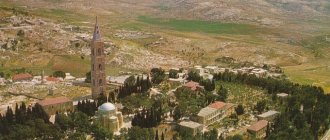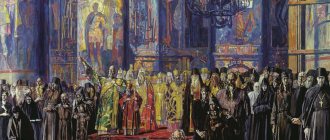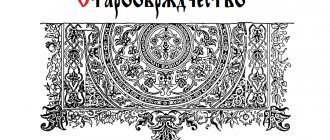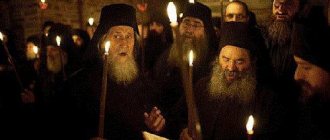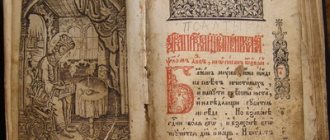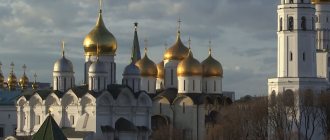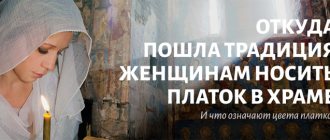Basic documents
Fundamentals of the social concept of the Russian Orthodox Church
Fundamentals of the teaching of the Russian Orthodox Church on dignity, freedom and human rights
Basic principles of the attitude of the Russian Orthodox Church to heterodoxy
Regulations on the election of the Patriarch of Moscow and All Rus'
Regulations on the composition of the Local Council of the Russian Orthodox Church
Regulations on the ecclesiastical court of the Russian Orthodox Church
Regulations on awards of the Russian Orthodox Church
On measures to preserve the memory of the new martyrs, confessors and all innocent atheists during the years of persecution who suffered
The concept of missionary activity of the Russian Orthodox Church
On the organization of missionary work in the Russian Orthodox Church
On religious-educational and catechetical ministry in the Russian Orthodox Church
On the principles of organizing social work in the Russian Orthodox Church
On the participation of the Russian Orthodox Church in the rehabilitation of drug addicts
On the organization of youth work in the Russian Orthodox Church
The position of the Church in connection with the development of technologies for recording and processing personal data
Position of the Russian Orthodox Church on family law reform and problems of juvenile justice
The attitude of the Russian Orthodox Church to deliberate public blasphemy and slander against the Church
Social activities of Orthodox Christians
The practice of statements and actions of hierarchs, clergy, monastics and laity during election campaigns. The problem of clergy nominating themselves for elections
Regulations on material and social support for clergy, clergy and workers of religious organizations of the Russian Orthodox Church, as well as members of their families
On the ordination of celibate persons who are not monastics
Position of the Russian Orthodox Church on current environmental issues
Statement of the Consecrated Council of Bishops of the Russian Orthodox Church on the life and problems of indigenous peoples
Orthodox mission and catechesis
Download in DOC
EPUB FB2 PDF
Ryabicheva Olga Leonidovna
St. Philaret Institute
The sacrament of baptism is traditionally considered the “gate of the Church” [ Afanasyev, 98
].
Through him, people entered and continue to enter the church meeting, determining its quality. In the Christian Church in the 2nd–4th centuries, the practice of teaching the truths of faith to those preparing for baptism developed. In the process of catechesis, specific requirements were presented to the catechumens, the failure of which left them outside the boundaries of the church meeting [ Yakuntsev, 24–34
].
Today sociological surveys show that more than 80% of Russians are baptized and consider themselves to be “Orthodox.” However, about a third of them do not believe in God [ Levada, 143
].
More than 60% of the “Orthodox” almost never go to church and do not take communion, that is, they do not live church life. The number of permanent parishioners is no more than 2–4% of the population [ FOM
].
Statistics for the last two to three decades on these indicators have not changed significantly. “Nominal” Orthodox [ Usatov, 44
] continue to treat the church as a religious complex [
mit.
Mercury ]. Many modern church leaders associate these problems with the lack of necessary preparation for the sacrament of baptism.
An analysis of documents of the Russian Orthodox Church and practical recommendations of the Synodal Department of Religious Education and Catechesis (OROiK) for the period from 1990 to 2021 in order to identify the conditions for admission to the sacrament of baptism showed that the requirements for new members of the church can be classified based on the principle of unity of faith , prayer and life [ Practical Guide, Issue 1, 47
]. This principle is derived by researchers based on the study of the ancient practice of catechesis, and modern church documents also refer to it. In particular, the documents contain requirements for those announced regarding their knowledge of the fundamentals of the doctrine, the acquisition of prayer and liturgical experience by those being baptized, future recipients and parents of baptized infants and repentance.
The fundamental condition for entering the Church was and remains the presence of faith in Christ. It is faith that determines the boundary that separates a member of the Church from an unbeliever. According to modern documents of the Russian Orthodox Church, during the catechumen it is supposed to teach people preparing to enter the church the basics of Christian doctrine through familiarity with the Holy Scriptures and the Creed. Thus, in the section of the “Concept of missionary activity of the Russian Orthodox Church” (2007), dedicated to the educational mission, it is said about the need for beginners to recognize the “Inspiration of the Holy Scripture” [ Concept, 376–377
].
Familiarity with the Holy Scriptures should take place during public conversations and presupposes that the catechumens are familiar with certain passages of the Holy Scriptures - the Gospel and the main biblical commandments [ On religious education, 189
]. The methodological manuals of OROiK stipulate forms of acquaintance with the Holy Scriptures: reading at meetings by the catechist of selected passages from Scripture with explanations, independent reading of Scripture by catechumens, answers by the catechist to questions that arose in them in connection with the reading, evangelical circles. The minimum requirement in preparation for the sacrament of baptism is the acquaintance of the catechumen with one of the Synoptic Gospels.
However, a survey of experts in this field: lay catechists and priests conducting catechism in Moscow parishes and outside parishes, revealed that the brevity of the catechism does not allow the catechist to assess how seriously a person has taken the word of Scripture, whether he recognizes its inspiration, and whether he relates it to his life. . Long-term catechesis (for example, in the Transfiguration Commonwealth of small Orthodox brotherhoods) makes it possible to use the Holy Scriptures to teach the catechumens the Orthodox faith and gain them the experience of knowledge of God.
The documents declare the need for those being baptized to consciously confess the Creed during the sacrament of baptism, which is in accordance with church tradition. However, in the experience of patristic catechesis, the transfer and “return” of the symbol existed as a single inextricable process [ Gavrilyuk, 9, 167
].
In modern catechetical practice, the transmission of a symbol in most cases exists in the form of familiarizing the catechumens with its text with the comments of the catechist. With minimal requirements, part of the time is allocated for this at one of two meetings, each of which lasts 1–1.5 hours [ Practical Guide, Issue 1, 50
].
During the sacrament of baptism, instead of “returning” the Creed, today it is enough to read it [ Catechism, 54
].
According to current church-wide documents, preparation for participation in the sacrament of baptism for adults includes their introduction into the prayer and liturgical life of the Church. This is also true for parents and recipients during infant baptism. The special role of receivers is emphasized by protopr. Nikolai Afanasyev in his work “Entry into the Church” [ Afanasyev, 86–93
].
According to documents read out between conversations and after them, it is recommended to attend church services. With longer catechesis at the main stage, regular temple prayer should become the norm for new converts. “It is advisable for them to attend church weekly, if possible, on Saturday evening (not necessarily from the beginning and not necessarily until the end of the service) and on Sunday morning (from the beginning to the end of the Liturgy of the Catechumens)” [ Belanovsky, 25
].
In practice, when conducting two minimal public conversations, which, as the results of the survey showed, usually take one to two weeks, the possibility of the catechumen’s participation in divine services is not discussed due to lack of time. During a longer catechumen (3–10 conversations), catechists, as a rule, also do not specifically call on the catechumens to go to church, where without additional explanations it can be difficult for the novice to understand what is happening, being read or sung. Listening to prayer requests and chants makes the Church Slavonic language difficult. Another St. Theophan the Recluse in the 19th century. wrote: “Our liturgical hymns are all edifying, thoughtful and sublime. They contain all theological science, and all Christian moral teaching, and all consolations, and all fears. Anyone who listens to them can do without any other teaching Christian books. Meanwhile, most of these hymns are completely incomprehensible... As a result, a new translation of the liturgical books is urgently needed” [ bp. Feofan, 143
].
The Liturgy of the Catechumens, which was originally a church service that allowed newcomers to hear the word of God and learn from it, today does not provide these opportunities. The question of the missionary and educational role of worship has been repeatedly raised in the documents of the Russian Orthodox Church in recent decades, often without correlation with the reality of catechetical practice, in isolation from the tasks of catechism. Today, in most churches, the perception of the Holy Scripture by ear and understanding of what is heard in addition to the Church Slavonic language is still made difficult by reading it on the throne in the altar, a dull iconostasis, poor acoustics and a specific manner of reading. Understanding the meaning of what you read is complicated by the fact that the sermon in most churches is heard in isolation from Scripture. Despite the fact that many priests and church hierarchs are aware that understanding the actions of the clergy, the prayers they read and the chants sung by the choir could make the participation of newcomers in worship less passive, more meaningful, and the service itself more effective, in practice changes are taking place So slow. As a result, the divine service in most cases remains ineffective for the catechumens.
Repentance as a correction of life associated with the renunciation of mortal sins, idolatry and everything that is ugly and improper is traditionally recognized by the church as one of the most important conditions for admission to the sacrament of baptism. This is still recorded at the level of general church documents. In the practical recommendations of OROiK and teaching aids for catechists, there are many references to the holy fathers, who unanimously affirmed the need to correct moral shortcomings and gain experience in good deeds before baptism. Today, in most cases, catechists do not demand that catechists renounce mortal sins. In relation to adults being baptized, it is expected to receive from them, during a repentant and confessional conversation, confirmation of their intention to abandon them. Entry into the fullness of church life is practically embodied in the participation of newcomers in parish initiatives.
In documents and in practice it is often said that everything that could not be achieved during the two obligatory catechesis conversations can be made up after baptism with the help of post-baptismal catechesis. Adult Sunday schools and Bible studies do provide opportunities today for a deeper understanding of Scripture and basic doctrine. But the majority of participants in the public conversations are the recipients and parents of baptized infants, whose initial goal is not to become acquainted with the faith and consciously enter the church, but to obtain permission to perform the necessary rite on their baby. Post-baptismal catechesis is not obligatory; not all past catechetical conversations are included in it, and, as a rule, there are no requirements or assessments of the quality of assimilation of religious doctrine.
Thus, in modern documents of the Russian Orthodox Church, the conditions for admission to the sacrament of baptism indicate the presence of faith and repentance, which correlates with the patristic tradition of catechesis. In the parish practice of Moscow, it was not possible to identify clear conditions for admission to the sacrament of baptism. When meeting the minimum requirements for disclosure, the tasks set in the documents are difficult to accomplish due to the short time allotted for conversations. Increasing the duration of the catechumen allows catechumens to become more familiar with the Holy Scriptures, consistently enter into the prayerful and liturgical experience of the church, and gain the experience of knowledge of God and effective repentance. Over the almost 30-year period under consideration, it was not possible to identify the sequence of development of theoretical provisions and practical recommendations in the field of preparing catechumens for the sacrament of baptism. It was also not possible to discover a method for determining the requirements for those being baptized. Modern documents and manuals are in little agreement with each other. Documents of recent years do not have a logical connection with documents adopted in an earlier period. In most cases, the surveyed catechists do not rely on current church documents in their practice. The introduction of mandatory minimum disclosure requirements in 2013 is gradually changing the attitude towards presenting requirements for those entering the church. However, the brevity of the catechism period does not allow catechists to enforce the conditions for admission to the sacrament of baptism specified in the documents. We see that the situation can only be seriously changed by a return to the patristic foundations of the practice of catechesis, which presupposes consistency and phasing, a developed system of requirements, as well as the testimony of the church about the catechumen’s acquisition of faith, effective repentance and real changes in life.
Bibliography
1. Afanasiev
= Afanasyev Nikolay, protopr. Joining the Church. M.: Pilgrim, Center for the Study of Religions, 1993. 203 p.
2. Belanovsky
= Belanovsky Yu.S., Rakushin A.V., Shestakov A.A. Catechesis in the Russian Orthodox Church at the present stage: textbook. a manual for students of courses on training catechists, missionaries and church educators. M., 2007. 38 p.
3. FOM
= Churching of the Orthodox. FOM. 2014. URL: https://fom.ru/TSennosti/11587 (date of access: 08/28/2018).
4. Gavrilyuk
= Gavrilyuk P. History of catechesis in the ancient church / Ed. priest Georgy Kochetkov. M.: St. Philaret Moscow Higher Orthodox Christian School, 2001. 320 p.
5. Golubinsky
= Golubinsky E.E. History of the Russian Church. T. 1: 1st half. 2nd ed. M: Imp. about history and Russian antiquities at Moscow. University, 1901. III–XXIV, 968 p.
6. Concept
= Concept of missionary activity of the Russian Orthodox Church. Collection of documents of the Russian Orthodox Church. M.: Publishing house of the Moscow Patriarchate of the Russian Orthodox Church, 2014. Vol. 2. Part 1. Activities of the Russian Orthodox Church. pp. 368–393.
7. Kochetkov Georgy, priest. A possible system of catechumen in the Russian Orthodox Church in modern conditions, 3rd ed., corrected and expanded. M.: Svyato-Filaretovskaya MVPKHSH, 1997. 36 p.
8. Kochetkov Georgy, priest. A sacramental introduction to Orthodox catechetics: Pastoral-theological principles and recommendations for those performing baptism and confirmation and preparation for them: Dissertation for the degree maitrise de theologie. M.: St. Philaret Moscow Higher Orthodox Christian School, 1998. 244 p.
9. mit. Mercury
= Mercury, Metropolitan of Rostov and Novocherkassk. Features of modern catechesis. Report at the IV All-Church Congress of Diocesan Missionaries November 16, 2010. URL: https://www.patriarchia.ru/db/text/1321003.htm (access date: 05/10/2018).
10. The most common distortions of church life. Their content and ways to overcome. Materials of the scientific and theological conference (Moscow, June 5–6, 2015) / Collection of articles. M.: St. Philaret Orthodox Christian Institute, 2021. 266 p.
11. About the Baptism of infants born with the help of a “surrogate mother”. Collection of documents of the Russian Orthodox Church. M.: Publishing house of the Moscow Patriarchate of the Russian Orthodox Church, 2014. Vol. 2. Part 1. Activities of the Russian Orthodox Church. P. 116.
12. About religious and educational
= About religious-educational and catechetical service in the Russian Orthodox Church. Collection of documents of the Russian Orthodox Church. M.: Publishing house of the Moscow Patriarchate of the Russian Orthodox Church, 2014. Vol. 2. Part 1: Activities of the Russian Orthodox Church. pp. 181–192.
13. Levada
= Public opinion - 2021. M.: Levada-Center, 2021. 244 p.
14. Announcement
= Announcement at the present stage: methodological material / General Department of Religious Education and Catechesis of the Russian Orthodox Church. M.: [b. i.], 2015. 56 p.
15. About mortal sins: Collection of materials for public conversations. M.: St. Philaret Orthodox Christian Institute, 2011. 120 p.
16. Practical guide
= Practical guide for a catechist. Vol. 1. M.: Foundation for the Preservation of Spiritual and Moral Culture “Pokrov”, 2014. 140 p.
17. Practical guide for a catechist. Vol. 2. M.: Foundation for the Preservation of Spiritual and Moral Culture “Pokrov”, 2021. 88 p.
18. Order of His Holiness Patriarch Kirill “On preparation for the Sacrament of Baptism” URL: https://eoro.ru/wp-content/uploads/2014/09/Order of His Holiness Patriarch Kirill on preparation for the Sacrament of Baptism dated April 3, 2013..pdf (accessed 19.09.2018).
19. Tradition of patristic catechesis: Collective scientific monograph / Under scientific. ed. priest Georgy Kochetkov. M.: St. Philaret Orthodox Christian Institute, 2014. 176 p.
20. Usatov
= Usatov Alexander, priest. Announcement at the present stage // Orthodox education: special supplement. 2013. 80 p.
21. Ep. Feofan
= Feofan (Govorov), bishop. Collection of letters. Vol. 2. M.: Tipo-Litogr. I. Efimova, 1898 (rep. reprint: M.: Palomnik, 1994). 253 pp.
22. Yakuntsev
= Yakuntsev V.I. Canonical norms related to the announcement // Tradition of patristic catechesis: Collective scientific monograph / Under scientific. ed. priest Georgy Kochetkov. M.: St. Philaret Orthodox Christian Institute, 2014. pp. 24–34.
23. Kelly JND Early Christian Creeds. Continuum, 2006. 456 p.
Source: Sretensky readings: Materials of the XXV scientific and theological conference of students, graduate students and young professionals: St. Philaret Orthodox Christian Institute (Moscow, February 23, 2021) / Comp. Z.M. Dashevskaya [Electronic resource]. M.: SFI, 2021. – 1 electron. wholesale disk (CD-ROM); 12 cm.
Materials of the Cathedrals
1. Resolutions of the Consecrated Council of Bishops of the Russian Orthodox Church
The document was adopted by the Council of Bishops of the Russian Orthodox Church on February 5, 2013.
2. Message of the Consecrated Council of Bishops to the clergy, monastics and laity of the Russian Orthodox Church
The document was adopted by the Council of Bishops of the Russian Orthodox Church on February 5, 2013.
3. On the adoption of a new edition of the Statute of the Russian Orthodox Church
The document was adopted by the Council of Bishops of the Russian Orthodox Church on February 5, 2013.
4. Regulations on the election of the Patriarch of Moscow and All Rus'
The document was adopted by the Council of Bishops of the Russian Orthodox Church on February 5, 2013.
5. Regulations on awards of the Russian Orthodox Church
The document was adopted by the Council of Bishops of the Russian Orthodox Church on February 5, 2013.
6. Regulations on material and social support for clergy, clergy and workers of religious organizations of the Russian Orthodox Church, as well as members of their families
The document was adopted by the Council of Bishops of the Russian Orthodox Church on February 4, 2013.
7. Position of the Russian Orthodox Church on current environmental issues
The document was adopted by the Council of Bishops of the Russian Orthodox Church on February 4, 2013.
8. The position of the Church in connection with the development of technologies for recording and processing personal data
The document was adopted by the Council of Bishops of the Russian Orthodox Church on February 4, 2013.
9. Position of the Russian Orthodox Church on family law reform and problems of juvenile justice
The document was adopted by the Council of Bishops of the Russian Orthodox Church on February 4, 2013.
10. On the election of the composition of the General Church Court of the Russian Orthodox Church
The document was adopted by the Council of Bishops of the Russian Orthodox Church on February 3, 2013.
11. Report of His Holiness Patriarch Kirill at the Council of Bishops of the Russian Orthodox Church (February 2, 2013)
His Holiness Patriarch Kirill of Moscow and All Rus' delivered a report to members of the Council of Bishops of the Russian Orthodox Church, who gathered in the Hall of Church Councils of the Cathedral of Christ the Savior on February 2, 2013.
12. On the principles of organizing social work in the Russian Orthodox Church
On February 4, 2011, the Council of Bishops of the Russian Orthodox Church adopted the document “On the principles of organizing social work in the Russian Orthodox Church.”
13. Statement of the Consecrated Council of Bishops of the Russian Orthodox Church on the life and problems of indigenous peoples
On February 3, 2011, members of the Council of Bishops of the Russian Orthodox Church adopted a Statement on the life and problems of indigenous peoples.
14. Definition “On the establishment of a special annual commemoration of the dead on Victory Day, May 9 (April 26)”
The Council of Bishops in 1994 established a special annual commemoration of the deceased - the warriors who laid down their lives for the faith, the Fatherland and the people, and all those who died sufferingly during the Great Patriotic War - on Victory Day, May 9, new style (April 26, old style).
15. Definition “On the “Second General Statement and Proposals to the Churches” of the Joint Commission on Theological Dialogue between the Orthodox and Oriental Orthodox Churches (Chambesy, Geneva, September 23-28, 1990)”
The 1994 Council of Bishops heard the report of the Synodal Theological Commission on the issue of the “Second General Statement and Proposals to the Churches” of the Mixed Commission on Theological Dialogue between the Orthodox and Eastern Orthodox Churches.
16. Definition “On the attitude of the Russian Orthodox Church to inter-Christian cooperation in the search for unity”
At the Council of Bishops in 1994, a definition was adopted “On the attitude of the Russian Orthodox Church to inter-Christian cooperation in the search for unity.”
17. Definition “On publishing activities”
The Council of Bishops in 1994 decided to create the Publishing Council of the Moscow Patriarchate.
18. Definition “On pseudo-Christian sects, neo-paganism and occultism”
The Council of Bishops in 1994 adopted a definition “On pseudo-Christian sects, neo-paganism and occultism.”
19. Definition “On the tasks of the Church in the field of theological education”
“Realizing that theological education is a priority church-wide task,” the Council of Bishops in 1994 adopted the definition “On the tasks of the Church in the field of theological education.”
20. Definition “On the tasks of the Church in the field of religious education”
The Council of Bishops in 1994 adopted the definition “On the tasks of the Church in the field of religious education,” Fr.
21. Determination regarding the appeal of the episcopate of the Ukrainian Orthodox Church regarding the granting of autocephaly to it
The Council of Bishops of the Russian Orthodox Church on March 31 - April 5, 1992 had a judgment on the appeal of the episcopate of the Ukrainian Orthodox Church regarding the granting of autocephaly to it.
22. Definition of the Ukrainian Orthodox Church
The determination of the Consecrated Council of Bishops of the Russian Orthodox Church on October 25–27, 1990 concerns the canonical status of the Ukrainian Orthodox Church.
23. Definition of the consecrated Council of Bishops of the Russian Orthodox Church (Moscow, June 24-29, 2008) “On the unity of the Church”
On June 27, the Council of Bishops of the Russian Orthodox Church at a plenary meeting adopted the definition “On the unity of the Church.”
24. Fundamentals of the teaching of the Russian Orthodox Church on dignity, freedom and human rights
The document was adopted at the plenary meeting of the Council of Bishops of the Russian Orthodox Church on June 26, 2008.
25. “About monasteries and monastic life”
Report of Archbishop Alexy of Orekhovo-Zuevsky, vicar of His Holiness the Patriarch of Moscow and All Rus', chairman of the Synodal Commission for Monasteries, at a meeting of the working group “Activities of parishes and monasteries” of the Bishops’ Council of the Russian Orthodox Church on June 25, 2008.
26. Determination of the Consecrated Council of Bishops on issues of external activity of the Church (Moscow, 2004)
The document was adopted at a meeting of the Bishops' Council of the Russian Orthodox Church on October 6, 2004.
27. The Royal Family and G.E. Rasputin
Appendix No. 3 to the report of Metropolitan Juvenaly of Krutitsy and Kolomna, Chairman of the Synodal Commission for the Canonization of Saints. June 7, 2008
28. On the issue of canonization of Tsar Ivan the Terrible and G. E. Rasputin
Appendix No. 2 to the report of Metropolitan Juvenaly of Krutitsy and Kolomna, Chairman of the Synodal Commission for the Canonization of Saints. June 7, 2008
How documents of modern church institutions are preserved
Today, most documents on the history of the Russian Orthodox Church are part of the Archival Fund of the Russian Federation and are stored mainly in federal archives, museums and libraries. These materials are available to researchers, but documents from modern institutions of the Russian Orthodox Church are extremely rarely introduced into scientific circulation. Experts express concern about the degree of completeness of their preservation, the lack of a single coordinating center in this matter, the degree of preparedness of documents for working with them and their accessibility for researchers. The editors of the magazine “Domestic Archives” asked clergy, church historians and researchers working with documents on church history to express their opinions on this issue. The materials of the round table were published in the new issue of the magazine “Domestic Archives” (2007. No. 4).
M.I.
Odintsov, Head of the Department for the Protection of Freedom of Conscience of the Office of the Commissioner for Human Rights in the Russian Federation, Doctor of Historical Sciences, Professor:
In accordance with the nature of the existing by the beginning of the 20th century. relations between the Russian state and religious organizations, maintaining church records and preserving materials on the activities of church institutions was a responsibility for all religious organizations. This is precisely what predetermined the fact that we have a huge archival fund concerning the religious life of Russia. Many diocesan bishops of the Russian Church, realizing the importance of preserving historical evidence, demanded that church parishes, monasteries and religious educational institutions constantly take care of church archives and include in their composition not only official materials, but also a wide variety of other information about church life. For example, we can refer to the works of the famous church and public figure, Metropolitan of Novgorod Arseny (Stadnitsky). For decades, Vladyka carefully collected documents and materials with which he worked and which he received from numerous correspondents. His huge personal fund, now stored in the GARF, is an inexhaustible storehouse of information on the history of the Russian Church in the 19th–20th centuries. He demanded the same approach to archival materials from his subordinates wherever he happened to serve.
After the revolutionary events of 1917, in the new state-church relations, official documentation of state significance (primarily acts of civil status) migrated from church funds to state archives, and the remaining part, recognized by the state as “unnecessary”, due to this circumstance remained in church institutions. Wars, revolutions, anti-religious ideological campaigns, redrawing borders between states and within states have had a negative impact on the composition of church archives - much has been lost irretrievably.
But let’s also give credit to those unmercenary people of the 1920s and 1930s who, by hook or by crook, managed to convince some of the state repositories to accept the “priest’s documents.” Thanks to them, we, for example, can see, read and explore the original materials of the Local Church Council of 1917–1918. Efforts to preserve materials about church life and such representatives of the Bolshevik elite as V.D. were extremely useful. Bonch-Bruevich, P.A. Krasikov A.V. Lunacharsky, P.G. Smidovich.
It’s a paradox, but the “saviors” of many church documents were also all kinds of punitive, controlling or ideological institutions of the Soviet era. It is clear that this was done solely from pragmatic aspirations, but this documentary layer often turns out to be the only source of our information about religious life in the USSR. Such, for example, is the fund of the Council for Religious Affairs of the Russian Orthodox Church (later - religious cults), stored in the GARF and containing tens of thousands of priceless documents.
The destruction of the USSR again had a detrimental effect on church archives, dooming them to division and loss.
The accessibility of church archives is not a problem of today. Suffice it to recall how difficult it was sometimes for Russian historians who turned to church topics to “penetrate” not only the archives of existing church institutions, but also the funds of state archives containing information on state-church relations necessary for their research. Often, numerous certificates, permits, approvals, and inspections were required. Likewise, in the Soviet era, the archives of church institutions or other institutions in contact with them were in state storage facilities in “closed” storage and were actually inaccessible. Only the last two decades have significantly changed the situation, and researchers can work with these materials. And we must thank again and again all the archivists who preserved documents on the history of our Fatherland.
The Soviet period aggravated the problem of archives of existing religious institutions. They were not in demand by the state; There were no private archives where they could be placed, and as a result, their fate largely depended on the personal initiative and desires of specific church officials. It can be argued that by the end of the Soviet period there were practically no such church archives.
The fate of archives at religious centers, including the Moscow Patriarchate, developed somewhat differently. In the post-revolutionary period, they all started from scratch, since documents and materials that previously belonged to them were requisitioned during various repeated searches. Gradually, a new body of documents was formed, which was completely closed to secular researchers. This situation continues today, when almost every church has an archive of this kind. Obviously, the question has arisen about developing rules according to which these archives could be transferred to state repositories.
Archimandrite Makariy (Veretennikov), Master of Theology, Professor of the Moscow Theological Academy, laureate of the Makariev Prize
: Archives and the materials contained in them are the repositories of our memory, our heritage, present and future. Initially in Rus', archives existed at princely residences, bishops' departments, monasteries, churches, boyar estates, etc. Office materials that were no longer in immediate use were set aside and stored separately. Later they emerged as independent, primarily government institutions. At the same time, the established tradition of careful and careful recording and storage of documentation was continued. The fate of church archives was affected by trends in domestic politics.
After the revolution, the Church lost its land, and then the function of recording the civil status of the population; the relevant documentation was transferred to government agencies, and the range of church documents narrowed. The subsequent persecution of the Church and the clergy led to the massive destruction of church documentation. The surviving church documents in the archives are only a small part of the church records collection. It should be noted that the preservation of documentation, “evidence”, in subsequent times in an environment of constant repression was quite dangerous. Then repressive measures against the Church weakened, but ideological oppression continued and did not weaken until very recently. However, life went on and found a certain reflection in the documents. But the Church was more often staffed by people who had reached retirement age, whose “education” the authorities were less involved in and worried about less. True, the professionalism of such personnel could leave the best, but in the conditions of the survival of the Church this was quite acceptable. The condition of church archival materials depended on the qualities of the personnel through whose hands they passed.
With the beginning of perestroika, a dialogue between the public and the clergy arose. In January 1988, at a meeting of teachers and students of the Moscow Theological Academy and the Historical and Archival Institute, the question of the state of church archives was raised. Today we can talk about the archives of parish churches, monasteries, religious educational institutions, dioceses and central church institutions. To what extent they are formed depends, first of all, on the duration of the institutions themselves. There appear to have been no instructions from the central government on this issue. In theological educational institutions, in the curricula, if this issue is mentioned, it is mainly in a historical context.
B.L.
Fonkic, corresponding member of the Academy of Athens, member of the International Committee on Greek Paleography, honorary doctor of the University of Thessaloniki.
Aristotle, Doctor of Historical Sciences, Professor: I think that almost 50 years of experience in studying Greek manuscripts and documents, work in libraries and museums of Moscow, St. Petersburg, Kiev, Lvov, Venice, Vatican, Florence, Munich, Berlin, Athens, Mount Athos monasteries, Oxford, London, Paris, Madrid, Sofia and many others allow me to say a few words about Greek manuscript books and documents stored in the monasteries of the Christian East.
Almost 65 thousand Greek manuscripts of the 4th–19th centuries, thousands of documents from the Byzantine and post-Byzantine periods of Greek history have survived to our time. Almost half of the Greek manuscript books (probably about 30 thousand) are located in various repositories of the Greek world (within the borders of the four eastern patriarchates); As for the documents, apparently, at least 90% of them belong to the Greek monastic archives and are located both in Greece itself (Athos, Meteora, Patmos, Thessalonica, etc.) and in Sinai, Palestine, and Cairo.
If all the manuscript funds concentrated in the state repositories of Europe have long been available for study, then the monastic collections of the Greek area, whether handwritten books or documents, to this day remain essentially inaccessible for their scientific development, for systematic work on them . Of course, the situation that existed in the 19th century has long since changed significantly for the better: many monastery libraries and archives are now well equipped; if you wish, you can even get a microfilm or other copy of any material, which is being conducted (or planned) in some places. ) cataloging of funds. But with all this, even in places that seem to have been developed by science for a long time, a specialist may be faced with the reluctance of the custodians to open their funds, give out the necessary materials, or generally show at least something. In our community there is a well-known case when in the 70s. XX century The Sinaiites refused to give 17 manuscripts of Gregory Nazianzus to the famous Belgian scientist Jacques Noret for his work. I myself, despite all my connections and acquaintances in the Greek scientific world, encountered refusals (and the “explanations” of the reasons were at the level of outright lies) in Meteora, on Patmos and even on the Holy Mountain.
The situation is somewhat easier when you are interested in handwritten books. If it comes to documents, then you can come across obstacles that a lifetime will not be enough to overcome. Suffice it to recall the background to the publication of the “Archives of Athos” by French Byzantinists! There are storage facilities that are closed to anyone for decades. For many years now, for example, the Lavra of St. Afanasia on Mount Athos does not want to allow specialists to study their funds.
Everything would be fine if the owners themselves wanted and knew how to research and catalog manuscripts and documents. But this almost never happens! At best, outside specialists are brought in, but this rarely leads to a positive result.
It seems to me that it is impossible to overcome the current situation - at least in the coming decades: there are no forces in Greek society that would be interested in this - neither among secular figures of science and culture, nor, especially, among the Orthodox Church.
E.V.
Starostin, Chairman of the section on problems of documents of church archives of the Central Council of the Russian Society of Historian-Archivists, Doctor of Historical Sciences, Professor:
The Russian Orthodox Church has made a huge contribution to the development of the economic, socio-political and spiritual-cultural life of Russia. Entire centuries of our history would have turned out to be a continuous blank spot if the historical monuments that emerged from the bowels of the Russian Orthodox Church had not been preserved. Generations of the living, at a minimum, should be grateful to the unknown guardians of our common historical and cultural heritage.
In the pre-revolutionary era, the Russian Orthodox Church created an effective document storage system: church ancient depositories, consistory and diocesan archives functioned in the cultural centers of the country, and theological academies collected excellent collections. At the beginning of the 20th century. In Russian government circles, the issue of creating a central church repository on the basis of the Archives of the Holy Synod was seriously discussed. After 1918 the Church lost a lot. Over time, of course, the state needs to return its documentary heritage to the Russian Orthodox Church in the form of originals or copies, but only if it ensures decent storage and the possibility of use. The first steps of the Church in this direction after the collapse of the USSR are not very encouraging: if church hierarchs understand the importance of preserving historical and cultural heritage, they leave it until the Greek calendar. A modern archive is expensive, and even more expensive is the training of qualified personnel and the maintenance of the structure of archives as carriers of the cultural spiritual memory of the people.
Positive changes are certainly taking place: record keeping in church institutions and the current storage of documents have been restored; the process of reconstructing local archives is underway; The Patriarchal Library in St. Andrew's Compound, along with publications, began to accept church funds; the archives of the KGB and other repressive bodies were studied to identify documents about the new martyrs; two directories-indexes of archival documents on the history of the Russian Orthodox Church appeared; at the Orthodox St. Tikhon's University for the Humanities since 2001, students have received educational services in historical and archival studies; the CS ROIA section held the first international conference on the archives of the Russian Orthodox Church in 2003; The Institute of History and Archives has opened a specialization in church archives and is preparing to publish the 1st volume of a guide to documents of the Russian Orthodox Church preserved in the state archives of Russia, Ukraine and Belarus. The publication of this substantial almost thousand-page publication, in the preparation of which archivists from three Slavic countries participated, will hopefully serve to intensify the vital work of preserving our historical memory.
Priest Andrei Dudin, head of the Vyatka Diocesan Archive (VEA):
In our diocese, the archive was recreated by decree of Archbishop Chrysanthus of Vyatka and Slobodsk on August 31, 1998.
It’s nice that the topic of preserving the archival heritage of the Russian Orthodox Church is once again relevant. Initially, it seemed that it consisted only in the lack of management of the archival fund of the Russian Orthodox Church, but the study of complexes of documents from the offices of different dioceses showed that the archival issue in the Church is a matter of the future. The vast majority of dioceses have been conducting their office work since the 1960s; it was insignificant in volume, so the office can handle this complex quite well. Over time, when the volume of diocesan records increases, the problem of storing and recording archival heritage will become more acute. In our diocese, it has already been resolved: the office stores documents for 10 years and transfers them to the VEA, diocesan parishes and departments of diocesan administration submit documents every 5 years, Vyatka Theological School - annually. This is the basic principle of compiling our archive. In addition, at the annual diocesan meeting, the head of the archive makes a special report in which he points out the shortcomings in this work in the parishes and ways to eliminate them.
Today there are 15 thousand units in VEA. archives, 47 funds, including early printed and handwritten books of the 16th–20th centuries. Most of the documents relate to the post-revolutionary period. This is not accidental, since the overwhelming majority of church archives, including the archive of the Vyatka Spiritual Consistory, after the closure of the diocese in 1936, were transferred to the State Archives of the Kirov Region. Among the most interesting are documents about repressed priests and laymen of the Vyatka land; a photographic fund constantly replenished with the help of parishioners, which contains over four thousand photographs of the clergy, churches of the diocese, and services from the end of the 19th century to the present.
VEA conducts excursions to the temples and monasteries of the city, takes part in pilgrimage trips, and the annual Trifonov educational readings. Archive staff prepare publications on historical topics in regional periodicals and the diocesan newspaper, exhibitions in museums and exhibition halls not only in the Kirov region, but also in other cities of Russia, in particular in Moscow, Vologda, Kostroma.
In 2007, as part of the 350th anniversary of the Vyatka diocese, the archive is preparing two exhibitions. On August 2, the exhibition “Vladyka Veniamin Tikhonitsky” will open, dedicated to the 50th anniversary of the death of this prominent hierarch of the Vyatka Church. Another exhibition will open in October in the building of the regional museum of local history and, as fully as possible, will present the treasures of the funds (more than 300 exhibits) of the diocesan archive.
The archive pays significant attention to updating the material and technical base. In 2008, BEA will celebrate its 10th anniversary. The first guide to the archive's holdings is being prepared as a gift to researchers. Work in this direction continues.
V.F.
Kozlov, Head of the Department of Regional History and Local History of the Institute for the Humanities of the Russian State University for the Humanities, Candidate of Historical Sciences, Associate Professor:
The problem of the availability and use of archival documents about the history and fate of churches and monasteries is becoming increasingly relevant today. Since the early 1990s. Only the Russian Orthodox Church has been given tens of thousands of churches and chapels, which have to be restored, collecting material for this in archives, libraries and museums. Communities are also faced with the task of writing and publishing a complete history of the temple and parish, organizing a current archive, and sometimes a simple museum exhibition.
It is known that almost all major archives of the Church, soon after the revolution of 1917, were transferred to state archives, i.e. were practically nationalized. Nevertheless, the documentation stored in state archives (funds of central, diocesan and parish church institutions - the Holy Synod, educational and charitable institutions, consistories, boards, committees, individual monasteries and churches) is not only accessible to researchers, but is also provided with scientific reference apparatus. The main problem that arises in this regard is the often high cost for communities of copying church documents for the needs of the temple, creating their own archive, museum, etc. Parishes should be given the right to widely copy former church documents at the cost of paper and consumables.
The same right should be given to the Church in the person of its parish and monastic communities when copying documents from institutions (administrative departments, church tables, cultural commissions, committees, etc.) stored in state archives that were involved in the 1920s–1980s. supervision of churches, repair and restoration work and storage of movable monuments (restoration workshops, museums, etc.). In the context of the almost complete cessation of documentation by churches of their life during the Soviet era, the funds of the above-mentioned state institutions often retain unique information about the last years of the life of the temple, its closure, and the fate of the property. Modern parishes should also have advantages in using these documents.
The problem of accessibility of visual sources – drawings, plans and, of course, photographs – is especially great for churches being restored. So, for example, for copying photographs in the photo library of the GNIMA named after. A.V. Shchusev (the funds of the Moscow Archaeological Society and the Central State Restoration Workshops) demand an exorbitantly high price from parishioners, as well as other categories of researchers. Modern church parishes have suffered greatly from state atheism in certain times, and they should be provided with the most favorable conditions for using documents stored in state archives.
At the same time, the modern Russian Orthodox Church has many archival problems. We have almost “lost” the 20-year history of the revival of churches and monasteries - perhaps one of the most vibrant and interesting periods in the history of the Church. The overwhelming majority of parish communities do not systematically record the events of their modern history, therefore many issues of the formation of communities, the transfer of churches to believers, repairs and restoration, beautification, and the organization of parish life remained undocumented. Modern parish reporting will leave history with dry, brief and rather boring reports. Perhaps we need to recall the obligatory practice before the revolution of keeping detailed church chronicles in each parish.
Temples and monasteries are playing an increasingly important role in the modern sociocultural life of cities and villages, regional history, and the development of the local history movement. The organization of systematic documentation of church and parish life and close cooperation of the Church with central and regional archival institutions is the most important common task. By the way, such cooperation could also be aimed at archival processing and introduction into scientific circulation of materials about the activities of the Church after 1917 that are still inaccessible to researchers. Such work has already begun in several regions.
Archpriest Boris Danilenko, director of the Synodal Library of the Moscow Patriarchate, candidate of theology:
The fate of church archives in modern Russia worries many experts, and for good reason. Before the revolution, the archival work of the Russian Orthodox Church, or more precisely, the Office of the Orthodox Confession, was brought to its proper height. When in our time we talk about an exemplary church archive, the first thing that comes to mind is the archive of the Holy Synod, which until recently was located in the bowels of the Russian State Historical Archive in St. Petersburg in the Synod building. Unfortunately, this archive has not been accessible to researchers for several years now. The Synodal Archive, meanwhile, was not only a model in terms of systematization and preservation of unique documents, but also an example of the stability of archival storage. From the moment of its creation until the first years of the new millennium, it was located in the same place, known to every church scientist, every Russian historian-archivist.
The Synodal Archives contains materials relating to the construction of churches and monasteries in the 18th–20th centuries: elevations of facades made in ink and watercolor with a special artistic gift. Many of the archive files contain truly unique information regarding the biographies of Russian hierarchs. Without knowledge of this archival collection, it is impossible to talk about the materials of the Study Committee and Orthodox spiritual missions, personal collections of church scholars and unfinished publishing projects.
Anyone who had the good fortune to work with synodal documents in the building on Senate Street opened old cardboard folders with signatures made in purple ink by the unforgettable K.Ya. Zdravomyslov, the last head of the Synodal Archive, can say without exaggeration: “I am involved in the Synodal era.” These folders stood on ancient shelves made many decades ago, no one dared to disturb their order and harmony... One could only be amazed that neither the First Imperialist War, nor the October Revolution, nor the Great Patriotic War, nor the Siege of Leningrad, nor the repressions of 1930 -1950s, neither the “Khrushchev thaw” with its atheistic frosts had any impact on the fate, or more precisely, the location of this church treasure in the cultural space of the city on the Neva. Nowadays, the Synodal Archive, like the entire RGIA, has been moved to a new location, and one can only console ourselves with the hope that a little time will pass and we, as before, will be able to use its treasures.
Of course, working conditions in the archive were bad. I remember how, five years ago, being there on frosty winter days, I was amazed at the resilience of the archive workers: they, wrapped in down scarves, worked at a temperature of thirteen degrees. They looked like January bullfinches... And it was difficult for the researchers themselves to work in poorly heated rooms, but first of all it is worth bowing to the heroism of the archive employees, continuers of the work of their pre-revolutionary predecessors. They became almost the only opponents of moving the archive.
I believe that a terrible mistake was made. Every place has its own genius. And, of course, the Synodal Archive also had a genius loci. Did he survive? Probably, each of the researchers who worked with the documents of this collection has the right to both personify such a genius and deny the very fact of his existence. But this is a personal matter... But none of us has the right to so treacherously dispose of the fate of the most significant church archive in Russia! Apparently, in a hurry, they again forgot about the scientific community - historians, philologists, theologians, in a word, about all those who know a lot about archival matters...
The future fate of the personal archives of modern Orthodox hierarchs, clergy, and church scientists is also a question about which we have to worry today. In Russia, even in the last century, a certain culture of the epistolary genre was alive. People wrote letters to each other. There are unique collections that include correspondence between church hierarchs, church scientists, representatives of the white and black clergy and simply the Russian intelligentsia with clergy. Suffice it to recall, probably, the best collection in this regard by N.N. Glubokovsky, stored in the Plekhanov House, in the branch of the manuscript department of the Russian National Library. People wrote to each other because they did not have the opportunity to speak “mouth to mouth” and could not meet in person. These letters contained everything: stories about what happened in the scientific, academic and church world, and reactions to certain events in pre-revolutionary Russia. The most secret thoughts were entrusted to letters, which were sometimes framed in the form of entire essays, essays... But time passed, and everything changed. First the telephone appeared, then the Internet, and, probably, after several decades, it will no longer be possible to speak about the work of modern humanities scholars in general and theologians in particular based on the materials of their correspondence. It seems to me that now our letters are of a purely clerical, notification nature. Even in the church environment they usually have no scientific significance. The discussion of this or that event does not take place in the form familiar to our predecessors - in the best case for later researchers, it comes down to electronic correspondence. It is difficult to find a written message that has emerged within the last year that sheds light on a particular research question in a field such as church history. The exception is international correspondence. Sometimes scientists still entrust their most intimate thoughts to notes and letters, turning to distant colleagues. But this is most likely a kind of tribute to the conspiracy theories of past years.
One of the problems of modern church archives is that they, like their sister libraries and museums, arise spontaneously. There are no church-wide regulations on the need to create them at diocesan administrations, monasteries, religious educational institutions and, especially, parishes. Where there are proactive and sufficiently professionally trained specialists, something happens. There are, thank God, good examples. Of course, “due to official necessity”, sooner or later office archives appear in all church institutions. But an organized “archival space” still does not exist in the Russian Orthodox Church. Dialogues are needed: dialogues between people who work as church scholars in secular archives, in secular manuscript collections, and between specialists who, representing the interests of government agencies and certain secular institutions, work or want to work with church materials. It seems to me that joint conferences, meetings, and dialogues are rarely held.
Recreated in 1987, the Synodal Library of the Moscow Patriarchate has become a “quiet haven” for some collections of church documents of interest to researchers. We are currently preparing a number of collection descriptions for printing. The collections of the Synodal Library, including its archival part, are available to all categories of readers. By the way, we took the principle of accessibility as fundamental even at the initial stage of the library’s activities.
Concluding what has been said, I would like to note that we, church people, would like to see in the activities of state archival institutions of modern Russia a model that can be imitated without fear of accountability before God and people.
Journals of the Holy Synod
1. On the participation of the Russian Orthodox Church in the rehabilitation of drug addicts
The document was adopted at a meeting of the Holy Synod of the Russian Orthodox Church on December 26, 2012 (journal No. 128).
2. Akathist to the Most Holy Theotokos in honor of Her icon “The Tsaritsa”, as well as akathists to the saints, approved by the Holy Synod on December 26, 2012
The Holy Synod at its meeting on December 26 (journal No. 131) approved for use during divine services and in home prayer the text of the akathist to the Most Holy Theotokos in honor of Her icon “The All-Tsarina,” as well as the texts of the akathists to the following saints: the Apostle Thomas, the Great Martyr Mercury of Caesarea, St. Gregory Palamas, Saint John of Shanghai and San Francisco, Saint Gerasim of Jordan, Simeon the New Theologian, Nicodemus the Holy Mountain.
3. Regulations on church approval of the activities of Orthodox public associations
The document was approved by the resolution of the Holy Synod of the Russian Orthodox Church dated December 27, 2011 (magazine No. 165).
4. On the organization of youth work in the Russian Orthodox Church
The document was approved on the basis of the determination of the Holy Synod of the Russian Orthodox Church dated October 5-6, 2011 (magazine No. 116).
5. Regulations on the Metropolises of the Russian Orthodox Church
The document was approved on the basis of the determination of the Holy Synod of the Russian Orthodox Church dated October 5-6, 2011 (magazine No. 131).
6. List of church offenses subject to consideration by church courts
The document was approved on the basis of the determination of the Holy Synod of the Russian Orthodox Church dated July 27, 2011 (magazine No. 86).
7. Regulations on the Supreme Church Council of the Russian Orthodox Church
The document was adopted at a meeting of the Holy Synod of the Russian Orthodox Church on March 22, 2011 (magazine No. 10).
